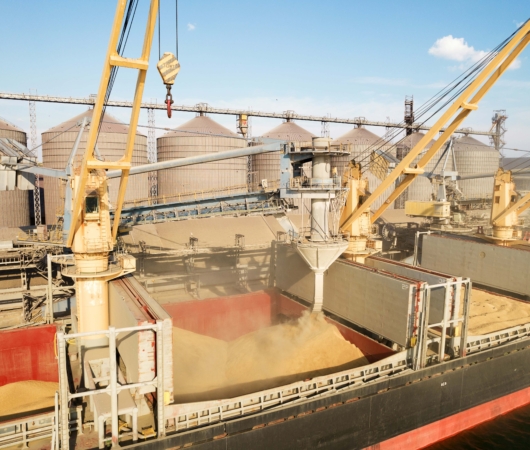PROTECTING YOUR CONSTRUCTION SITE FROM THEFT
PROPERTY CRIME IS A GROWING TREND. ASCOT LOSS CONTROL IS HERE TO HELP CLIENTS MITIGATE LOSS.
Thefts can occur any time, day or night, and construction sites can be easy targets. Many sites, often containing a considerable number of high value and/ or mobile items, do not adhere to critical loss prevention techniques. For example, they may not be adequately lit or are unattended on nights and weekends.
Commonly stolen items include lumber, copper, power tools, and equipment such as loaders, skid steers, excavators, and trailers. These thefts are leading to annual losses estimated at $1 billion not including indirect losses related to productivity loss and delays.
Despite a rise in losses, there are many accessible and low-cost loss prevention recommendations that property owners can follow to mitigate risk on their construction site.
What can you do to prevent theft losses?
While there are no guarantees, there are risk control measures that site managers can implement to help protect their property. As it relates to theft of equipment, materials or tools on site, consider the following:
Secure your Location/ Site: Use fencing, locks, gates, etc. Ensure that there are no openings or gaps in your fence or perimeter. Fencing should be high enough to protect the site and should not be easy to climb. All access points should be secured and locked upon leaving the site each workday. Store high value items in buildings or secured areas, away from the perimeter. Use high quality locks to secure access points and equipment. Change and/ or rekey locks on a regular basis. All trailers should be secured using high quality trailer hitch locks.
Install Security Cameras: Surveillance cameras and related technology have made huge advancements over the years in affordability, image quality, functionality, and ability to remotely monitor job sites from a computer or smartphone. Ensure cameras are strategically placed to obtain a view of the entire site.
Provide Good Lighting: Ensure that there is adequate lighting throughout the job site and eliminate any “dark” areas that would allow thieves to hide or operate without detection. Regularly inspect lighting and replace any damaged or burned out bulbs as needed. Lights can be damaged or blocked over time as a job progresses.
CASE STUDY
A recent theft claim for an insured’s job site involved the foreman arriving in the morning to find that thieves had cut the lock to the gate and proceeded to drive onto the site and cut the lock to a storage container that was being used as an office trailer. Thieves stole small high-valued tools as well as rented GPS equipment from the trailer and then moved on to steal the GPS units in several pieces of mobile equipment. To better protect their site in the future, the insured has since upgraded the types of locks being used on the gates and trailers and added surveillance cameras. The tools and GPS equipment were valued at over $185,000.
Practice Inventory Control: Label all tools and equipment. Keep and maintain a detailed inventory, including make, model, serial number and photos. Having your name on the equipment in two places, one obvious and the other in an inconspicuous area (e.g. etching, engraving, or other permanent means) will assist in recovery if the equipment is stolen.
Require Tool Sign-In/ Sign-Outs: All tools and equipment should be signed in and out each day and returned to the proper storage locker or location at the end of each shift. Assigning accountability to the foreman and other supervisors on the job can help ensure that equipment and tools are tracked and returned at the end of the work day. Bring expensive equipment on site only when necessary and remove when no longer needed.
Harness Relevant Technology: Potential technology solutions include GPS, RFID, Bluetooth, and geofencing to track and manage assets. Use of automated drones and AI are growing quickly within the industry — drones can be programmed to fly regular missions and use AI detection sensors to send notifications in real time. When replacing equipment, consider new technology such as keypads and PIN codes to start equipment, kill switches, or remotely operated disconnect switches to power down stolen items.
Conduct Regular Inspections: Inspections can help identify potential gaps on your site related to security, lighting, and equipment and tool storage.
Mandate Training: Raising awareness for theft prevention and site security with all employees and sub contractors can go a long way to prevent future thefts. Employees can be another set of eyes on the job site — setting up a formal reporting system can pay dividends. Many jobsite thefts are inside jobs, thus properly vetting employees is an important aspect of protecting your company’s assets. Hiring procedures should be adopted to include conducting formal background checks and pre-hire drug and alcohol testing.
Contact David A. Larson, U.S. Head of Loss Control & Risk Management, to learn more about our loss control capabilities.
Loss prevention consultation services (“Services”) are provided on behalf of insurance company affiliates within the Ascot US group of insurers. Services are intended to assist the policyholder or contracted firms with the mitigation or elimination of potential loss producing situations. Any information provided is not intended as legal advice or legal counsel and is not intended to assure compliance with or complete analysis of any law, rule, or regulation. There is no warranty, express or implied, that all potential hazards and conditions have been evaluated or identified or that potential hazards are safely controlled. Not all products and services are available in every jurisdiction, and the precise coverage afforded by any insurer is subject to the actual terms and conditions of the policies as issued. Not all products and services are available in every jurisdiction, and some may be available in the United States only on a surplus line basis through licensed surplus line brokers. The publication and delivery of the information contained herein is not intended as a solicitation for the purchase of insurance on any US risk. California Surplus Lines License: Ascot General Insurance Agency, Inc. License #: 0K61371.



